 |
Site created 12/15/97.

page created: 7/6/04
 Barrie Maxwell - Main Page |
| Classic
Reviews Roundup #7 - July 2004 May seems to be war month for most of the major releasers so this outing of the Classic Reviews Round-Up covers a number of such offerings related to 20th century wars from Warner Bros. (Back to Bataan, Battleground, The Flying Leathernecks), Fox (Crash Dive, The Enemy Below, The Hunters, Morituri, What Price Glory), MGM (Hell in the Pacific, The Last Valley, Too Late the Hero), and Paramount (The Winds of War). We also go back to wars prior to the 20th century to look at The 300 Spartans (Fox), Helen of Troy (WB), and The Last Valley (MGM). The reviews are ordered by releasing studio. Crash Dive (1943) What Price Glory (1952) The Enemy Below (1957) The Hunters (1958) The 300 Spartans (1962) Morituri (1965) (all released on DVD by Fox on May 25th, 2004 This is the fourth wave of war films from Fox and each offering to date has included a nice variety of items. Settings this time range from World War I on the ground (What Price Glory), to World War II on the water (Crash Dive, The Enemy Below, Morituri) to the Korean War in the air (The Hunters). Then we return to the Greeks and the Persians at Thermopylae (The 300 Spartans). 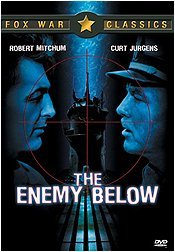 The class of this wave is The Enemy Below which, after a false start in 2003, Fox has now been able to release in Region 1. Its arrival is welcome for it's one of the more intelligent war films out there. Set in the South Atlantic during World War II, it pits the captain of an American destroyer against his counterpart in a German U-boat. The film's basic premise and the execution of the plot offers little out of the ordinary for a war film, but the portrayal of the captains is handled very skillfully and thoughtfully by Robert Mitchum and Curt Jurgens. Mitchum's character is a former merchant ship's officer whose loss of that ship prompted him to join the navy so that he could be "on the shooting rather than receiving end" as he puts it. At first viewed as a dabbler by his crew, they soon recognize his level of skill and experience as he continually manages to match the German captain's own expertise. Mitchum gives his character his standard blend of easy-going yet ultimately forceful professionalism. Jurgens' German captain is a more introspective man, a veteran of World War I submarine warfare and now a professional naval officer who questions the merits and ultimate success of the German war effort. Both men prove to be reluctant warriors who know they are just doing a job the best they can and both in the end recognize each other's strength. The work of Mitchum and Jurgens elevates the film above many of its contemporaries and makes it still well worth seeing. The Enemy Below was directed by Dick Powell who by the mid-1950s had for the most part withdrawn from acting to concentrate on behind-the-camera activities. He co-founded "Four Star Television" which produced a number of anthology-type programs such as Four Star Playhouse and The Dick Powell Show. Powell was also the director of The Conqueror (1956) filmed near a Utah atomic test site and a film that saw many of its participants, including its star, John Wayne, suffer cancer in later years. Powell's direction of The Enemy Below is assured, as he handles dialogue and action scenes equally efficiently. Look for future television stars David Hedison (billed as Al Hedison) and Doug McClure (unbilled) in supporting roles. Fox presents the CinemaScope film in a 2.35:1 anamorphic transfer that looks excellent in all respects from colour fidelity to black levels and shadow detail to lack of age-related debris. The Dolby 4.0 sound is also quite effective with some noticeable if subtle use of the surrounds. Spanish and French mono tracks as well as English and Spanish subtitles are provided. Supplements consist of three Movietone newsreels related to wartime U-boat action, the theatrical trailer, and trailers for other Fox war classics. Recommended. 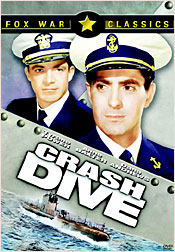 Crash Dive is the only film of the group made during the Second World War and its ending offers the usual boosterism for the fighting forces. Tyrone Power headlines the cast playing one of his typical God's-gift-to-women roles. The only problem this time is that the woman he's after (played by Anne Baxter) is the sweetheart of the captain (Dana Andrews) of the submarine he's assigned to. Aside from this back story, there's considerable submarine action as Power and Andrews' ship attempts to find and destroy a secret German naval base in the North Atlantic. The action is excitingly staged by veteran director Archie Mayo. The studios commonly tried to dress up some of their wartime propaganda films with Technicolor (such as Dive Bomber and Captains of the Clouds, from Warners, and Halls of Montezuma from Fox). Crash Dive, despite its predictable plot, didn't really need the colour boost due to its fine star power and action, but it provides one extra reason to enjoy the film. Fox's full-frame transfer (in accord with the original theatrical ratio) is a very good one. The source material is obviously in very good shape and the result is a vibrant, finely detailed image with only minor debris and speckling. The only deficiency is a couple of short sequences where colour fidelity wavers somewhat. The Dolby stereo sound is adequate with clear dialogue and decent presence during the action scenes. Mono tracks and sub-titles are provided in both English and Spanish. The only supplements are the theatrical trailer and trailers for other Fox war classics. Recommended.  What Price Glory was based on the Maxwell Anderson play that first had a good stage run in 1924-1925 and then was made into a film starring Victor McLaglen in 1926. Its story involves the relationship between two soldiers, Captain Flagg and Sergeant Quirt, and their mutual interest in a French village woman. With as much comedy as tragedy about the futility of war, the play and film were both high points of the 1920s. Fox decided to remake the film in the early 1950s as a musical and interested James Cagney in portraying Captain Flagg because of the musical approach. John Ford agreed to direct due to his personal fondness for the play, but when he heard about the musical idea, he rejected it flatly. As a result, Cagney was unhappy, but he had a contract for this one picture so he toughed it out. The results are not happy. Both Cagney and his co-star (Dan Dailey as Quirt) were generally allowed to ham it up by Ford and the play's balance between comedy and tragedy suffers fatally. Instead of "war is hell", it seemed too much like "war is a hell of a good time". Of course, no Cagney film is without value for his presence elevates anything he's in, but on the whole it was a "miss' during a decade of hit and miss films. Fox continues its winning steak with another very fine image transfer. The full frame rendition (in accord with the original aspect ratio) of the Technicolor film is very bright and clean with vibrant colour (almost too much so for some of the subject matter), deep blacks, good shadow detail, and minimal dirt and debris. The Dolby stereo sound is in good shape with clear dialogue and some presence to the war scenes. English and Spanish mono tracks and sub-titles are provided. Supplements consist of a theatrical teaser and trailer, and trailers for other Fox war classics.  Lately, Robert Wagner seems to be everywhere when it comes to Fox releases from the 1950s. Prince Valiant, Let's Make It Legal, What Price Glory, and now The Hunters all offered him substantial parts. In the latter he's a hot-shot rookie pilot during the Korean War, who must help his commanding officer (Robert Mitchum) effect a daring rescue of his commander's wingman (Lee Phillips) who has been shot down behind enemy lines. Mitchum of course is the star of the film and he gets involved with his wingman's wife (Mai Britt) as a complication to the whole situation. Mitchum is his usual effective self; Wagner gives a strong if predictable performance; and the film builds some decent tension courtesy of tight direction by Dick Powell. Yet, there's a general feeling of having-seen-it-all-before about this one that isn't entirely overcome by the cast and director's efforts. The film's real highlight is the photography of the aerial sequences. Fox's 2.35:1 anamorphic transfer is another winner overall although problematic flesh tones from time to time are somewhat intrusive. Colours have good fidelity; blacks are deep; and shadow detail is very good. The flip side of the disc contains a useless full-frame version of the film. Dirt and debris are minimal. The Dolby 4.0 sound is very effective with noticeable use of the surrounds, some decent presence to the action scenes, and otherwise clear dialogue. English and Spanish sub-titles are provided. Supplements consist of a Movietone newsreel on the film's premiere, a teaser and trailer, and trailers for other Fox war classics.  Morituri (later also known as Saboteur: Code Name Morituri) was a nautical reunion of sorts for producer Aaron Rosenberg, Marlon Brando, and Trevor Howard. The three had been central to the 1962 remake of Mutiny on the Bounty. In Morituri, the setting was the Second World War with Brando as an agent (with a German background) for the British aboard a German freighter transporting a valuable cargo of rubber across the Pacific. Brando (who has been coerced into his espionage role by a British Intelligence officer (Howard, in a small role) must battle through a cat and mouse game with the ship's captain (a "good" German played by Yul Brynner) and the ship's first officer ( a confirmed Nazi, played by Martin Benrath). The film is a thinking man's wartime espionage tale that gradually transforms what appears to be a straight-forward task for Brando into a complicated web of treachery. The suspense is built convincingly by German director Bernard Wicki (who ironically was accused by Brando of being too perfectionistic with his numerous takes for some scenes). Notable in the film is its fine black and white photography by Conrad Hall. Of the main players, the honours go to Yul Brynner. Brando's efforts were at least an improvement over his previous outing (Bedtime Story). Fox's 1.85:1 anamorphic transfer is quite decent-looking. Shadow detail is good and the image is generally quite sharp, but the overall sense is of a slightly gray image characterized by a lack of deep blacks. The Dolby stereo sound is in reasonable shape with clear dialogue and some degree of presence in the action sequences. English and Spanish mono tracks and sub-titles are provided. Supplements consist of a theatrical teaser and trailer, and trailers for other Fox war classics. Recommended. 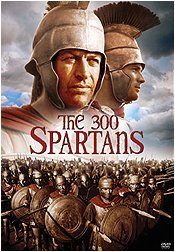 At a time when ancient history is being re-fought on the screen in the likes of Gladiator, Troy, and the forthcoming Alexander, it's appropriate to see how Hollywood was handling such events some 40 years ago. The 300 Spartans, from 1962, gives us Richard Egan, Ralph Richardson, and Diane Baker starring in a recreation of the resistance of a brave band of 300 Spartans who attempt to hold back the Persian army intent on invading Greece at Thermopylae during the 5th century B.C. Egan plays Leonidas, the head of the brave Spartans while Richardson is Themistocles of Athens. At the time of the event, Greece was a collection of city states of which Athens and Sparta were the main ones. The film gives some flavour of the inter-city-state rivalries involved and the use of Greek location shooting adds authenticity, but the whole effort is just a little too talky (with some rather wooden acting) and bland. Even the climactic battle scenes lack real drama, aside from the initial shot of the wedge of Spartans intersecting the Persian army. The colourful wide screen boasts some impressive-looking images (probably equally attributable to cinematographer Geoffrey Unsworth and director Rudolph Maté, a former cinematographer), but the film never conveys the scope of a true epic. At least Fox's 2.35:1 anamorphic transfer shows it all in its best light. The image is bright and colourful with deep blacks and good shadow detail. There is some minor speckling and a bit of grain, but overall fans of the film will be very pleased. The Dolby stereo sound is unremarkable, but is at least free of age-related defects such as hiss or distortion. English and Spanish mono tracks and sub-titles are provided. Supplements consist of three TV promotional teasers, English and Spanish theatrical trailers, and trailers for three other Fox historical epics. Hell in the Pacific (1968) The Last Valley (1970) Too Late the Hero (1970) (all released on DVD by MGM on May 25th, 2004) These are all titles previously released on DVD by Anchor Bay in 2001 when that company had gained the rights from Disney. With that agreement now expired and a new one in place between Disney and MGM, we now have the three films available under the MGM imprimatur. That means some nice new transfers, right? Wrong, these are the same old, same old; so if you have the Anchor Bay efforts, you can save yourself some money here.  The best film of this bunch has perversely the poorest of the DVD transfers. The Last Valley was conceived as a major epic in the twilight days of the road show presentation, but the background canvas of the 30 Years War in the 17th century is only vaguely sketched in, so that rather than an epic tale, we get a more intimate, contained story. That's not a complaint, for the result is an engrossing character study of how men adapt their ways of life and their own existence to fit circumstance, but how little impact those efforts may have in the end. The Last Valley is literally a secluded alpine valley that has managed to avoid the terror and rape of pillaging armies and soldiers of fortune that characterize both sides of the sectarian conflict of the 30 Years War. Then one such group of men led by the Captain stumbles on the valley, but is dissuaded from destroying its inhabitants and their homes by Vogel, a teacher who is on the run from the War and has himself come upon the valley by chance. Instead, convinced to treat the valley as a winter way station, the Captain finds himself caught up in the valley's life and the intrigues of its inhabitants. Michael Caine gives an introspective, yet quietly forceful performance as the Captain while Omar Sharif portrays the enigmatic Vogel. The story has the typical intelligence of a James Clavell script. As director, Clavell also manages to convey the claustrophobic nature of the secluded valley, but some abrupt cuts in the completed film hint at the more epic sweep originally intended. Despite that, the results provide a thoughtful film experience that goes beyond the genre's norm. Unfortunately, the film experience on DVD (2.35:1, but not anamorphically enhanced) is disappointing. The image is inconsistent - bright, colourful, and sharp in one sequence, then dull and washed-out in another. Grain is excessive, and motion artifacts are annoyingly common. The mono sound is clear enough, but only hints at the fidelity of John Barry's fine score. English, French, and Spanish sub-titles are provided. There are no supplements.  Hell in the Pacific tells a Robinson-Crusoe-like tale of a Japanese and an American soldier, both stranded on an otherwise deserted island in the Pacific during the Second World War. As presented, the story is more about how the two come to accommodate each other's presence than about the mechanics of personal survival in such circumstances. Toshiro Mifune and Lee Marvin both give convincing performances and the film presents each player's dialogue only in their native language so that the audience can identify most closely with the difficulties of whichever character speaks their language. The situation has considerable initial novelty, but the film loses steam about half-way through. Only when the characters manage to contrive a way to get off the island is momentum regained. The ending is abrupt and will likely provide mixed emotions. An alternate ending (reportedly director John Boorman's original choice) provided as a supplement on the DVD is equally ambivalent. The 2.35:1 image transfer, despite not being anamorphically enhanced, looks fairly sharp with only modest dirt and debris in evidence. Colours are natural although not as lush-looking as the setting might suggest they would be. There is modest grain present on occasion. The mono sound is quite adequate for this dialogue-driven film. A Japanese mono track and English, French, and Spanish sub-titles are also provided. The only supplement is an alternate ending, as mentioned above.  Too Late the Hero is a Pacific island World War II story of a more conventional type. Cliff Robertson plays reluctant American soldier Lieutenant Sam Lawson who is loaned to the British because of his Japanese language skills. Lawson's assignment is to accompany a British patrol that is to infiltrate the Japanese position on the island the British and Japanese jointly hold, and destroy the Japanese communications system. The British squad, generally composed of malcontents, is commanded by mild-mannered Captain Hornsby (Denholm Elliott) and includes the cynical Private Tosh Hearne (Michael Caine). Hearne and Lawson eventually find themselves tossed together to ensure the carrying out of the patrol's task. The film is directed by Robert Aldrich and bears the stamp of his typically successful and action-oriented war films, but in this instance is undermined by a plot full of implausibilities (unnecessary open field crossings, failures by the Japanese to carry out obvious ways to subvert the patrol's progress in particular and the British presence on the island in general, a ridiculous loudspeaker network, etc.). If you can overlook those, however, you will find the film diverting if predictable, with fine performances by both Caine and Robertson. The supporting work by Denholm Elliott and familiar British character actors such as Ian Bannen and Harry Andrews is also a plus. The tale is obviously a comment on the Vietnam War which was becoming increasingly unpopular at the time, and the title shot of the gradually decaying Japanese, British, and American flags gives us an inkling of the viewpoint to expect. Watch also for Henry Fonda in a small supporting role. MGM's DVD release provides a 1.78:1 anamorphic transfer which appears to be correctly framed (although for theatrical release, some prints were blown up to 70mm for an aspect ratio of 2.00:1). The image is generally sharp with good colour and fine shadow detail. Age-related speckling and some dirt and debris is in evidence. There are a few instances of edge effects, but not of significant concern. The mono sound is quite adequate with clear dialogue and some presence during the action sequences. English, French, and Spanish sub-titles are provided. The only supplement is the original theatrical trailer. The Winds of War (1983) (released on DVD by Paramount on May 25th, 2004) 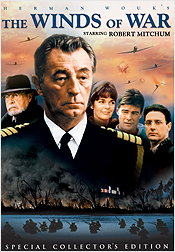 Twenty to twenty-five years ago when network television had a much bigger slice of the television-watching pie, the mounting of impressive and lengthy mini-series was not uncommon. Perhaps the most ambitious such effort was the filmization of Herman Wouk's two best sellers about the Second World War - The Winds of War and War and Remembrance. The former consisted of seven parts running almost 15 hours appeared in 1983 and the latter twelve parts running almost 25 hours appeared in 1988. Both appeared on ABC and both were at least partly productions of Paramount Television. Paramount has now made The Winds of War available on DVD in a six-disc box set that I highly recommend. The mini-series is a painless way to gain an appreciation of the events of World War II as told through the eyes of the Henry family consisting of Victor "Pug" Henry (a naval officer who becomes a confidante of President Roosevelt and finds himself assigned to key centres of the war from Berlin to London to Moscow to Pearl Harbor), his wife Rhoda, and his three adult children, Byron, Madeline, and Warren. The power of Wouk's novel is well preserved, partly because Wouk has adapted his own work for the film. The cast is well chosen with its main strength lying in its many supporting characters, particularly Polly Bergen as Rhoda, Peter Graves as Palmer Kirby, David Dukes as Leslie Slote, Victoria Tennant as Pamela Tudsbury, and Jan-Michael Vincent as Byron. Unfortunately the key roles of Pug Henry and Natalie Jastrow (whose uncle's determination to stay in Italy places her in constant jeopardy thus drawing in Byron who has fallen in love with her) are lacking. Robert Mitchum is too old for the part of Pug Henry (as would be even more obvious in the sequel) although he does bring a suitable level of gravitas to the role. Ali McGraw as Natalie is a real disappointment as she too often overacts and fails to convey why either of Byron or Leslie Slote would be in the slightest interested in her. Real historical characters are for the most part well recreated, particularly by Ralph Bellamy as Roosevelt and Howard Lang as Churchill. Gunter Meisner as Adolf Hitler is less persuasive, appearing too cartoonish at times. Director Dan Curtis marshaled the huge cast through an incredibly complex filming schedule that took place throughout Europe and America (although mainly in Yugoslavia which was able to stand in for a number of European locations). Attention to detail was high and the whole production has a classy look to it. Bob Cobert's original theme music is very memorable. The overall result is a particularly adept combination of historical detail and dramatic back story that takes the time to cover the war's many complexities and makes it all fascinating. Historical purists may scoff at the approach, but that's too often a typical reaction of the academic. Paramount spreads the seven parts over six discs with all supplementary content placed on the fourth disc. The full frame image (in accord with the original television presentation) is quite acceptable. Colours are generally subdued, but the image is crisp and clear for the most part. There is noticeable grain at times, and dirt and debris on the source material is more apparent than on most Paramount efforts. The Dolby mono sound is clear, without apparent age-related hiss or distortion. English subtitles are provided. Supplements consist of about an hour and a quarter's worth of new material spread over four featurettes: Making The Winds of War, A Novel for Television, Cast and Characters, and On Location. Combined these give a decent appreciation of the effort involved in the lengthy filming process. Each segment contains new interview material from the likes of director and producer Dan Curtis, associate producers Barbara Steele and Branko Lustig, and cast members Ali McGraw, Peter Graves, Polly Bergen, and Victoria Tennant. Highly recommended. As a footnote, readers should be aware that the continuation of the story, War and Remembrance, is already available in two box sets from MPI. As I have not seen these myself, however, I can't comment on their level of quality. Paramount has no current plans to acquire the rights to War and Remembrance and issue a DVD set itself. Back to Bataan (1945) Battleground (1949) Flying Leathernecks (1951) (all released on DVD by Warner Bros. on May 4th, 2004) Helen of Troy (1955) (released on DVD by Warner Bros. on April 27th, 2004) Warners' contribution to the list of new war releases features three World War II sagas, two of which star John Wayne in propaganda-type RKO presentations. These are sandwiched around Battleground's fairly sturdy recreation of one platoon's action during the Battle of the Bulge, originally released by MGM. Then for a complete change of pace, we travel back to the time of the Trojan War. 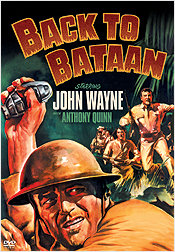 Back to Bataan is the real flag waver of the group. Conceived just after MacArthur's return to the Philippines in October 1944, the film extolled the virtues of the Filipino people and was rushed into production to take advantage of the steady progress that American and Filipino forces were then making in reclaiming Bataan and Corregidor from Japanese occupation. John Wayne stars as an American colonel who acts as liaison with Filipino regular and guerrilla forces throughout the period from the fall of Corregidor to the return of American forces and their freeing of American POWs who had been held captive for up to three years. Anthony Quinn appears as a captain of the Philippine Scouts. The story line that involves them unfortunately comes across as rather muddled as Wayne character keeps popping in and out of the narrative. Fortunately, the film contains some very good action sequences, crisply directed by Edward Dmytryk, which help to redeem it somewhat. The Filipino people are uniformly portrayed as good, gentle, and courageous, as might be expected, while the Japanese are predictably shown as completely without redeeming virtue. The likes of Philip Ahn, Richard Loo, and Abner Biberman were kept busy by Hollywood throughout the war portraying evil Japanese soldiers and leaders, and all three are employed in Back to Bataan to good effect. A nice touch, and one well received at the time of the film's original release, is the parade of actual American POWs freed in the Philippines and all identified by name and place of origin on screen. Overall, however, the film does not have a great repeat viewing potential. Warner Bros.' DVD does quite a good job in presenting a fairly crisp image. It's full frame in accord with the original aspect ratio. Source material dirt and debris is minor. Black levels are deep; shadow detail is generally good. The mono sound is in good shape with little evidence of age-related hiss or distortion. English, French, and Spanish sub-titles are provided. Uncharacteristically for Warners, there is no supplementary material whatsoever. For John Wayne fans only.  John Wayne was also a main reason to see 1951's Flying Leathernecks, an RKO (then under the ownership of Howard Hughes) film that hoped to capitalize on the popularity of a new wave of World War II films that began in 1949. In keeping with that wave, it's less of a flag-waver and more character-driven, although there are some cold-war (despite the WW2 setting) propaganda-type utterances. Wayne plays Major Dan Kirby, the new head of a Marine fighter squadron in the South Pacific. He is a hard man who is generally disliked by the men under his command, including his executive officer, Captain Carl Griffin played by Robert Ryan. The plot follows familiar ground already well harvested by the likes of Command Decision and Twelve O'Clock High, but suffers in comparison due to familiarity and a looser narrative. The film does benefit from some exciting aerial sequences and the use of Technicolor. The presence of the under-appreciated Robert Ryan is also a plus, although his role is too patly written to give him a chance to really shine. Warner Bros.' DVD does a very fine job with this Technicolor material although I was thrown off briefly by the appearance of the RKO logo in black and white to start. The full frame image (in accord with the OAR) is sharp and nicely detailed with good colour fidelity. Speckling and debris is minimal. The mono is unremarkable. English, French, and Spanish sub-titles are provided. The only supplement is the original theatrical trailer.  Battleground is the best film of the Warner releases. The film originated with Dore Schary when he was in charge of production at RKO in 1947. Schary wanted to do a film that showed that World War II was worth fighting despite the cost and he settled on the Battle of the Bulge as an appropriate setting. He commissioned a script from writer Bob Pirosh who had actually participated in the Battle and Pirosh produced an effort that focused on the story of one squad during that conflict with the emphasis on how the men felt and how they were affected by their experiences. Schary moved over to MGM after Howard Hughes acquired RKO, taking the Battleground project with him. MGM contract players Van Johnson, Ricardo Montalban, John Hodiak, and George Murphy co-starred and veteran William Wellman was persuaded by both the quality of the script and a nice chunk of cash to take on the direction. The film premiered in early November 1949 to both critical and popular acclaim and went on to become MGM's highest grossing film in five years. It would be nominated for six Academy Awards, winning for its script and for its black and white cinematography. Now some 55 years later, the film retains its power although its premise of following one squad in action is a much more familiar one to audiences now than it was then. The acting is sincere and captivating (although it does take a while to reconcile oneself to seeing MGM's mainly musical players out of their milieu) while the film has a look of gritty reality to it even though it was virtually all shot on the MGM back lot. Warner Bros.' full frame (in accord with the OAR) release looks very good with only some slight grain to mar the otherwise crisp and clear image. Shadow detail is very good and source material defects are minimal. The mono sound track is in good shape with hiss and crackle virtually absent. English, French, and Spanish sub-titles are also provided. Supplements consist of a mediocre Pete Smith short Let's Cogitate and a superior Tex Avery cartoon, Little Rural Riding Hood. Recommended. 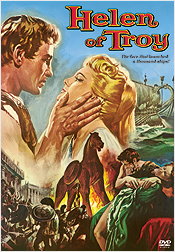 The more one delves into director Robert Wise's career, the more one realizes how versatile a director he was. From noir to westerns to musicals to science fiction to horror, he had the touch to make it work. In 1955, he even tried his hand at historical epic, or in this case mythological epic, in the filming of Helen of Troy. The film is a recounting of Homer's "Iliad" in which the city of Troy is laid siege to by the Greeks because the Trojan prince Paris returned to Troy after a failed peace mission but bringing with him Helen, the wife of King Menelaus of Sparta. The siege, lasting 10 years according to myth, and involving a thousand Greek ships culminates in the famous Trojan horse ruse. The film is a fairly successful attempt to translate the familiar story to the screen. The film holds one's interest, for despite a fairly superficial script, Wise makes good use of CinemaScope in what would be his first experience with the new process. He successfully conveys the scope of the event through the impressive city of Troy, the massive Greek forces, and well photographed and edited action sequences. In the latter, he is well aided by veteran second-unit director Yakima Canutt. Helen (in the person of Rossana Podesta) is appropriately beautiful, while Paris (Jack Sernas) is impossibly so. The rest of the cast is an interesting mix, ranging from British actors Stanley Baker and Harry Andrews (as Achilles and Hector respectively) to Sir Cedric Hardwicke as a very wise and regal King Priam of Troy, to American B-movie actors Eduardo Cianelli and Marc Lawrence as Andros and Diomedes respectively, and even to Brigitte Bardot in pre-sex kitten days. Filming was done in Rome, with Wise and about three dozen crew brought in from Warners. Warner Bros.' DVD of Helen of Troy is a 2.35:1 anamorphic presentation that makes the film look just swell. The image is crisp and clear with minimal print damage in evidence. The Warnercolor is quite vibrant and picture detail is very good. A very nice effort indeed. Warners has also opted for a new Dolby 5.1 sound track that provides some nice presence to the audio and subtle use of the surrounds. Max Steiner's majestic score is well served, especially since the film's overture is included. Also included are a French mono track and English, French, and Spanish sub-titles. Supplements consist of the theatrical trailer and three Behind the Cameras segments focusing on the making-of the film. Hosted by Gig Young, these originally appeared on the Warner Bros. Presents television series. Totaling less than 20 minutes, these nevertheless do provide a useful contemporary background to the film-making effort. Recommended. That's it for now. The next review round-up will either cover a raft of westerns or several box sets that need my attention. Barrie Maxwell barriemaxwell@thedigitalbits.com |
Barrie Maxwell - Main Page
 |
| Site
designed for 1024 x 768 resolution, using 16M colors and .gif 89a
animation. © 1997-2015 The Digital Bits, Inc., All Rights Reserved. billhunt@thedigitalbits.com |